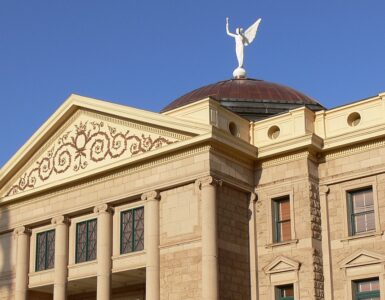The “Old Pueblo” is pushing aside its laid back image to become a major hub in the Southwest for huge distribution centers. In the past 12 months, several titans including Amazon have announced plans to build projects here.
MTD, a manufacturer and distributor of outdoor power equipment like lawn mowers for the masses, is readying to open its new distribution center on the southeast side. Defense contractor Raytheon Missile Systems is expanding its facilities nearby, and Target and HomeGoods built distribution centers here within the past few years.
“It’s catching attention and other distribution centers are starting to identify us,” said John Moffatt, Pima County Director of Economic Development. “We’re developing the Sonoran Corridor to open up the area southeast of Tucson for industry and primarily logistics.”
Its most recent plum is Amazon. Worth almost $1 trillion, the internet commerce giant just announced plans to build a massive “fulfillment center” warehouse on the southeast side that will create 1,500 new full-time jobs.
The Amazon project alone is expected to generate $600 million over five years, said Laura Shaw, chief marketing officer for Sun Corridor, Inc., that coordinates all economic development activities within the Southern Arizona megaregion.
Pima County and Tucson also are racing to compete with other cities for another major distribution center whose name is under wraps for now.
It’s all about location, location, Moffatt said.

All within three miles is the only rail line on the Union Pacific in Arizona, the airport, the Port of Tucson, and the proposed Sonoran Corridor that will connect the I-19 and I-10 highways that go to Mexico. Environmental impact studies are underway to prepare for the 16-mile corridor that will connect two major employment centers, extend rail service, improve freight movement and airport access, and reduce commute times. The corridor is projected to contribute $3.2 billion dollars annually to the local economy.
Tucson is an appealing option for corporations because it has a workforce and low priced housing and land compared to other big cities, said Moffatt, who confirmed that no financial incentives were offered to attract Amazon.
“The biggest incentive was that the county processed all permits and building plans for this huge building in less than five days,” he said. “And the Port of Tucson had it shovel-ready so they can move in quickly.”
Amazon’s plan calls for an 855,000-square-foot building at 6701 S. Kolb Road. It will handle incoming and outgoing products for the internet retailer to fulfill customer orders in Arizona and the Southwest. The project is being developed by Seefried Industrial Properties.
Amazon employees at the center will pick, pack, and ship small items to customers such as books, electronics, home goods, video games, office supplies, echo devices, and software, said an Amazon spokesperson, Lauren Lynch.
“Think anything on Amazon.com that is less than 18 inches,” Lynch said.
In Phoenix, Amazon’s 3.3 million square feet of fulfillment operations generate $380 million in economic development every ten years, said Christine Mackay, economic development director for Phoenix. They employ 5,300 employees.
“What’s best about them is they do have competitive wages but more importantly they promote from within,” Mackay said. “These are not just low wage jobs. They hire engineers, managers, software developers, and everyone who has to make sure the facilities run and operate.”
Amazon offers entry level to highly skilled jobs with medical benefits, parental leave, 95 percent paid tuition, and a 401k. Its wages and salaries tend to be competitive and it typically pays higher than minimum wage and retail, often about 30 percent higher, Lynch said.
This will be the fifth Amazon fulfillment center in Arizona. Currently, there are four in Arizona with 7,000 employees. Amazon’s investments pumped about $900 million into the state’s economy between 2011 and 2016, indirectly creating another 18,000 jobs.
“Tucson and Southern Arizona are really a region on the move,” said Shaw, of Sun Corridor. “Look for more great news in the future.”















